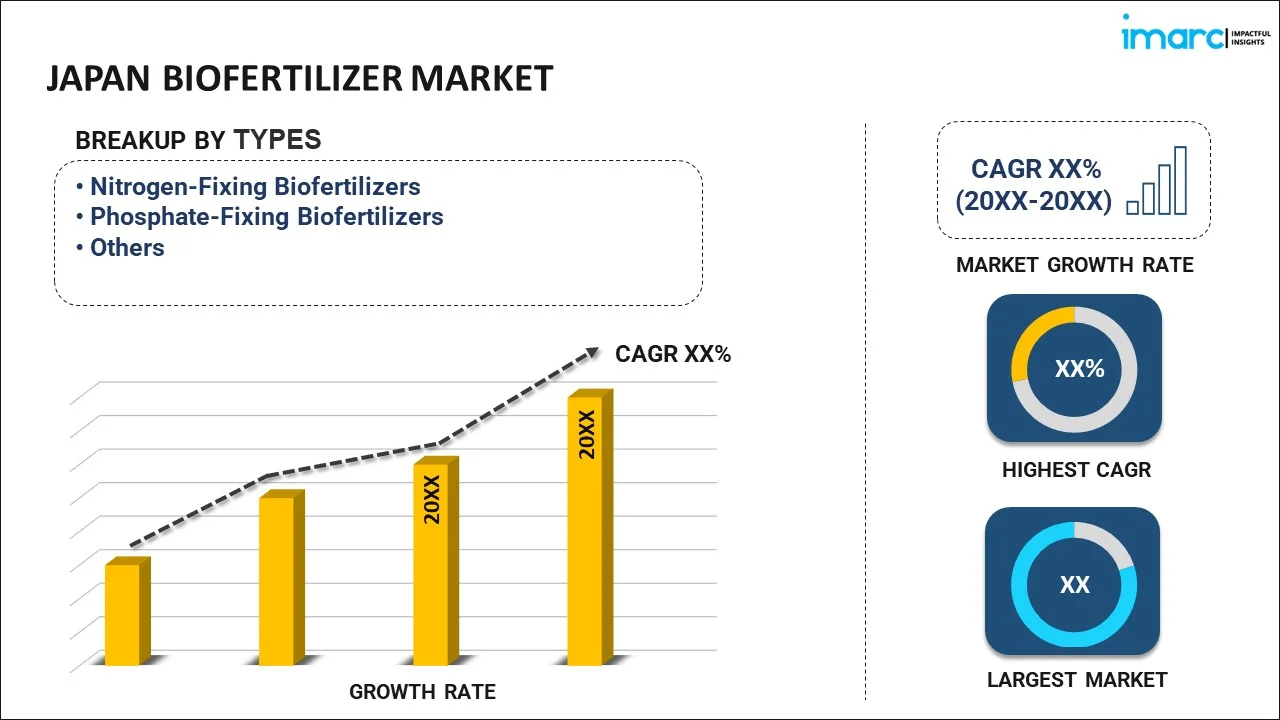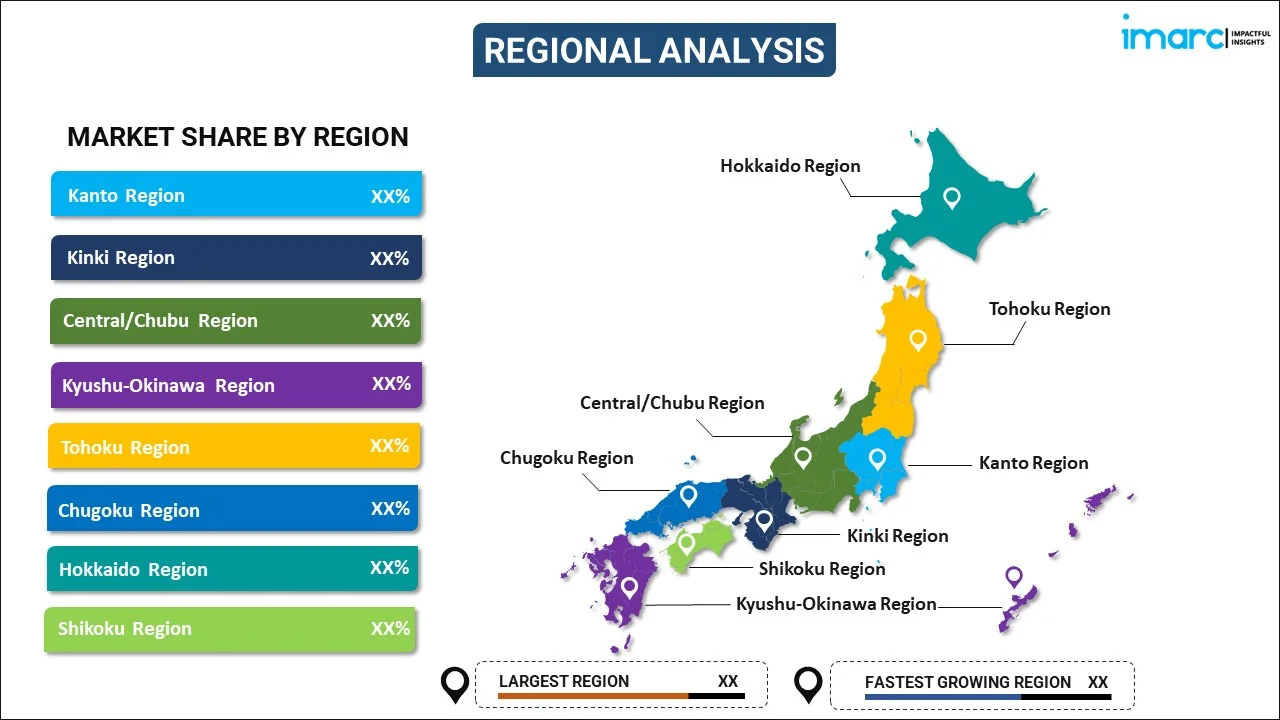
Japan Biofertilizer Market Report by Type (Nitrogen-Fixing Biofertilizers, Phosphate-Fixing Biofertilizers, and Others), Crop (Cereals and Grains, Pulses and Oilseeds, Fruits and Vegetables, and Others), Microorganism (Cyanobacter, Rhizobium, Phosphate Solubilizing Bacteria, Azotobacter, and Others), Mode of Application (Seed Treatment, Soil Treatment, and Others), and Region 2025-2033
Market Overview:
The Japan biofertilizer market size reached USD 94.0 Million in 2024. Looking forward, IMARC Group expects the market to reach USD 233.0 Million by 2033, exhibiting a growth rate (CAGR) of 10.6% during 2025-2033.
|
Report Attribute
|
Key Statistics
|
|---|---|
|
Base Year
|
2024
|
|
Forecast Years
|
2025-2033
|
|
Historical Years
|
2019-2024
|
|
Market Size in 2024
|
USD 94.0 Million |
|
Market Forecast in 2033
|
USD 233.0 Million |
| Market Growth Rate 2025-2033 | 10.6% |
Biofertilizers are natural substances made from biological wastes containing microorganisms, such as bacteria, fungi, and cyanobacteria. They aid in increasing the fertility of soil and crops by supplying essential nutrients, including nitrogen and potassium, to the host plant. Biofertilizers can symbiotically associate with plant roots and convert complex organic material into simpler compounds, which, in turn, enriches the soil with organic matter and promotes plant growth. Biofertilizers also create unsuitable living conditions for pathogens, thereby resulting in the prevention of crop diseases. Apart from this, they are cost-effective and free from chemicals, on account of which, they are widely preferred over synthetic fertilizers.
Japan Biofertilizer Market Trends:
The widespread adoption of sustainable agriculture practices due to the rising environmental concerns are currently driving the Japan biofertilizer market growth. Additionally, the increasing health consciousness and significant shift toward organic and healthy foods are further escalating the product demand. In line with this, rice is the predominant crop grown in Japan that requires flooded soil. The increasing use of synthetic fertilizers has elevated the nitrogen levels of underground water, which is creating an unavoidable continuum of environmental hazards across the country. This, in turn, has prompted farmers to shift toward bio alternatives of fertilizers to improve yield. Other than this, the Government of Japan (GoJ) is undertaking several initiatives, such as farm-level extension and subsidies on sale and direct production, which is creating positive growth opportunities for the market. Moreover, various technological advancements, including strain improvement using genomic and biotechnological tools, for better nutrient fixation and plant growth are creating a positive outlook for the market.
Key Market Segmentation:
IMARC Group provides an analysis of the key trends in each sub-segment of the Japan biofertilizer market report, along with forecasts at the country and regional level from 2025-2033. Our report has categorized the market based on type, crop, microorganism and mode of application.
Breakup by Type:

- Nitrogen-Fixing Biofertilizers
- Phosphate-Fixing Biofertilizers
- Others
Breakup by Crop:
- Cereals and Grains
- Pulses and Oilseeds
- Fruits and Vegetables
- Others
Breakup by Microorganism:
- Cyanobacter
- Rhizobium
- Phosphate Solubilizing Bacteria
- Azotobacter
- Others
Breakup by Mode of Application:
- Seed Treatment
- Soil Treatment
- Others
Breakup by Region:

- Kanto Region
- Kinki Region
- Central/ Chubu Region
- Kyushu-Okinawa Region
- Tohoku Region
- Chugoku Region
- Hokkaido Region
- Shikoku Region
Competitive Landscape:
The competitive landscape of the industry has also been examined along with the profiles of the key players.
Report Coverage:
| Report Features | Details |
|---|---|
| Base Year of the Analysis | 2024 |
| Historical Period | 2019-2024 |
| Forecast Period | 2025-2033 |
| Units | Million USD |
| Segment Coverage | Type, Crop, Microorganism, Mode of Application, Region |
| Region Covered | Kanto Region, Kinki Region, Central/ Chubu Region, Kyushu-Okinawa Region, Tohoku Region, Chugoku Region, Hokkaido Region, Shikoku Region |
| Customization Scope | 10% Free Customization |
| Post-Sale Analyst Support | 10-12 Weeks |
| Delivery Format | PDF and Excel through Email (We can also provide the editable version of the report in PPT/Word format on special request) |
Key Questions Answered in This Report
The Japan biofertilizer market was valued at USD 94.0 Million in 2024.
We expect the Japan biofertilizer market to exhibit a CAGR of 10.6% during 2025-2033.
The rising demand for organic and healthy food products, along with the growing popularity of biofertilizers, as they aid in increasing the fertility of soil by supplying essential nutrients to the host plant, is primarily driving the Japan biofertilizer market.
The sudden outbreak of the COVID-19 pandemic had led to the implementation of stringent lockdown regulations across the nation, resulting in the temporary halt in numerous agricultural activities, thereby negatively impacting the Japan market for biofertilizers.
Based on the type, the Japan biofertilizer market has been divided into nitrogen-fixing biofertilizers, phosphate-fixing biofertilizers, and others. Among these, nitrogen-fixing biofertilizers currently exhibit a clear dominance in the market.
Based on the crop, the Japan biofertilizer market can be categorized into cereals and grains, pulses and oilseeds, fruits and vegetables, and others. Currently, cereals and grains account for the majority of the total market share.
Based on the microorganism, the Japan biofertilizer market has been segregated into cyanobacter, rhizobium, phosphate solubilizing bacteria, azotobacter, and others, where cyanobacter currently exhibits a clear dominance in the market.
Based on the mode of application, the Japan biofertilizer market can be bifurcated into seed treatment, soil treatment, and others. Currently, seed treatment holds the largest market share.
On a regional level, the market has been classified into Kanto region, Kinki region, Central/ Chubu region, Kyushu-Okinawa region, Tohoku region, Chugoku region, Hokkaido region, and Shikoku region.
Need more help?
- Speak to our experienced analysts for insights on the current market scenarios.
- Include additional segments and countries to customize the report as per your requirement.
- Gain an unparalleled competitive advantage in your domain by understanding how to utilize the report and positively impacting your operations and revenue.
- For further assistance, please connect with our analysts.
 Inquire Before Buying
Inquire Before Buying
 Speak to an Analyst
Speak to an Analyst
 Request Brochure
Request Brochure
 Request Customization
Request Customization




.webp)




.webp)












